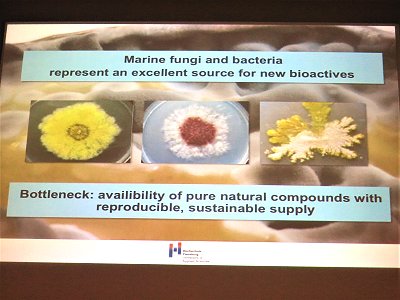Biotechnology of Marine Natural Products
 Prof. Antje Labes of the University of Flensburg focused her talk on the challenges of discovering active compounds in marine organisms that might be useful in new generations of medecines or other applications. Stimulated by the finding that prialt, a substance developed from a marine snail and 10 times more powerful than morphine in pain management, but without the side effects of morphine, the race was on to find new molecules.
Prof. Antje Labes of the University of Flensburg focused her talk on the challenges of discovering active compounds in marine organisms that might be useful in new generations of medecines or other applications. Stimulated by the finding that prialt, a substance developed from a marine snail and 10 times more powerful than morphine in pain management, but without the side effects of morphine, the race was on to find new molecules.
A wide-spread approach was to use bacteria, such as Pseudomonas, to produce quantities of the basic complex structure of e.g. an anti-cancer component or inhibitors of physiological pathways of diseases. If the bacterium was successfully induced to produce the molecule, the next step would then be laboratory synthesis to complete the active substance. But researchers were finding that the road from discovery to a marketable product was long and thorny.
Step one in this approach was to find a suitable culture medium so that the bacteria would actually produce the desired component. Culture media are specific for each taxon and the environmental conditions that are being mimicked to trigger the production.
This search is supported by building libraries of compounds. Despite these efforts to improve discovery, the lack of basic knowledge it is still very much at the stage of trial and error.
 Genetic markers are often used to enhance the predictability of the active substance and its production, but again, the gaps in understanding often result in only partial success.
Genetic markers are often used to enhance the predictability of the active substance and its production, but again, the gaps in understanding often result in only partial success.
The secondary metabolites of an active component are usually sensitive to environmental conditions in the laboratory. In order to become more efficient in scaling up the producesses it seems most promising to study them in nature and then try to copy without the need for large-sized catalysers which would not fit into laboratory-based bacterial helpers such as Escherichia coli.
These few sketches illustrate already how difficult the search and production processes are. A concerted effort into basic research to reduce the costly hit and miss approaches is likely to pay off more than more trials that are even often difficult to interprete because of the large number of variables and the difficulties to establish "simple" cause-effect relationships.








